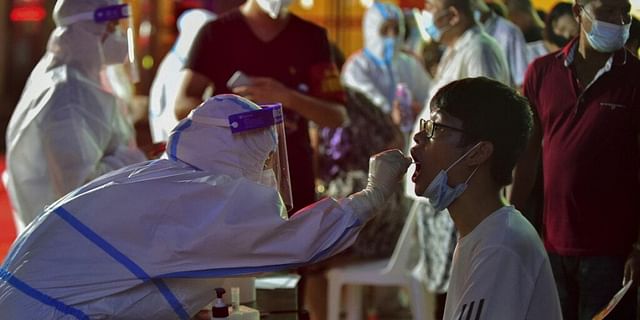 BEIJING: China is expected to continue its much-criticised Zero COVID policy, shutting the country to most of the world as a new study has warned of a “colossal outbreak” with over 6.30 lakh patients per day if it opens up.
BEIJING: China is expected to continue its much-criticised Zero COVID policy, shutting the country to most of the world as a new study has warned of a “colossal outbreak” with over 6.30 lakh patients per day if it opens up.
According to a report by the Peking University mathematicians, China could face more than 630,000 coronavirus infections a day if it dropped its zero-tolerance approach and followed other countries by lifting travel bans.
“The estimates revealed the real possibility of a colossal outbreak which would almost certainly put an unbearable burden on the medical system,” the report said.
China on Saturday reported 23 new COVID-19 cases, including 20 imported ones as the country appears to have contained a recent spike of infections in Beijing and other cities.
China, where the coronavirus first surfaced in Wuhan in late 2019 before it turned into a pandemic, has so far reported 98,631 cases and 4,636 deaths, the National Health Commission said on Sunday.
This included 785 patients still receiving treatment.
On Saturday, Chinese top respiratory expert Zhong Nanshan warned that the new and more contagious coronavirus variant Omicron, reported in South Africa causing global alarm, may cause more challenges to the work of preventing and controlling the pandemic as the World Health Organization (WHO) said it carries a large number of mutations.
He said that about 76.8 per cent of China’s population have been vaccinated, laying a good basis for the country to reach the target of 80 per cent vaccination to build herd immunity by year end.
One of China’s major vaccine producers, Sinovac Biotech, told state-run Global Times that the company is paying close attention to Omicron and has tapped into a global partner network to collect and obtain information and samples specific to the mutant virus.
On the new variant, Chinese experts believe there is no need to panic as the large number of mutations does not necessarily indicate high infectivity, and China, with a strict and experienced epidemic prevention and control system, is able to protect domestic residents from the new variant, a Global Times report said.
As the outbreak turned into a pandemic, China shut itself mostly with flight bans to most of the countries, including India, and did not permit thousands of foreign students, including 23,000 from India, studying in Chinese universities despite scathing criticism.
Earlier, China had no option but to aim for zero infections because the coronavirus was replicating quickly and the global death rate of about 2 per cent was unacceptable, Zhong told state-run CGTN-TV.
In a report published in China CDC Weekly by the Chinese Centre for Disease Control and Prevention, the four mathematicians from Peking University argued that China was not ready and could not afford to lift entry-exit quarantine measures without more efficient vaccinations or specific treatment.
Currently, people arriving from abroad have to undergo a 21-day quarantine in designated hotels.
Using data for August from the US, Britain, Israel, Spain and France, the mathematicians looked at the potential results if China adopted similar pandemic response strategies to those used in the selected countries.
In August, most of these countries had presented higher vaccination rates than China, where 54 per cent of the eligible population were inoculated.
These countries also had a higher natural immunity ratio, despite having lower population densities than China.
The researchers estimated that China would have more than 637,155 daily confirmed cases if it went down the same pandemic strategy path as the US, which had an average of 150,098 daily cases towards the end of August.
The report said China would have had 275,793 cases if it took the same approach as Britain and 454,198 cases if it followed France.
“Our findings have raised a clear warning that, for the time being, we are not ready to embrace ‘opening-up strategies and rely solely on the hypothesis of herd immunity induced by vaccination advocated by certain Western countries,” Hong Kong-based South China Morning Post quoted the report.
However, the study did acknowledge the estimates were based on basic arithmetic calculations and that more sophisticated dynamic models were needed to study the evolution of the pandemic if travel restrictions were lifted.
The researchers said that China would need a range of preparations in place – including more efficient vaccination coverage and specific treatment, different levels of non-pharmaceutical interventions and more hospital beds – before it could safely transition to opening-up strategies.
Recent Random Post:















